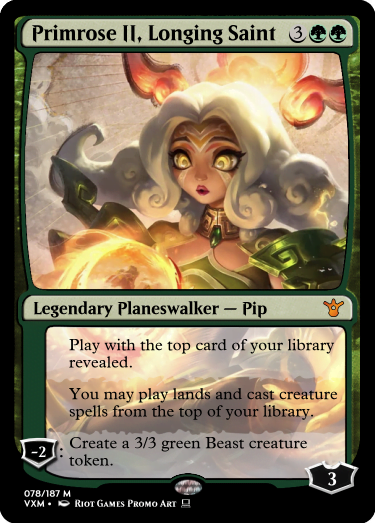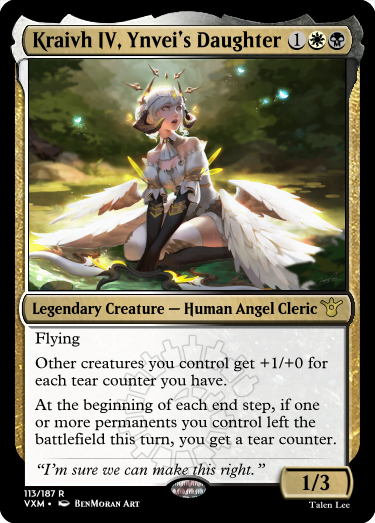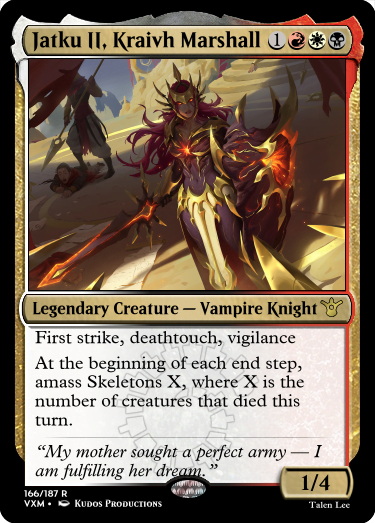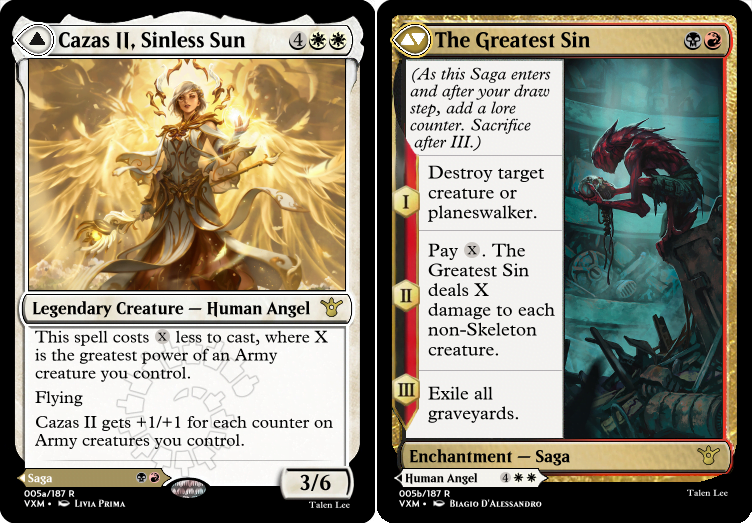What follows here is a discussion of what, if I had the means and writer tools to make my Custom Magic set have proper story spotlight material, it’d look like this, it’d be built out of this. This is basically about story mechanics underlying a game system, and I want to present it to you so you can have a handle on what it looks like when I’m trying to explain game narratives for the presentation of conventional narratives.
This first section is going to be the establishing shot; it discusses the characters that are going to be introduced, the goals of this story section, and then the beats of the story that the writer can then take as their subsequent storytelling. This helps inform character dynamics for flavour text and the later appearances of characters on cards.
Vox Maxima is a custom magic set created by Talen Lee. It’s composed of 187 cards, with 71 commons, 60 uncommons, 41 rares, and 15 mythic rares. Vox Decima is a custom Magic: The Gathering set, with at least one card spoiled a day, on Cohost, Kind.Social, and the r/custommagic subreddit.
WOTC Employees: This post in full presents unsolicited custom Magic: The Gathering card designs, which I understand current employee practices forbid you from looking at unsolicited. You shouldn’t be here!
Goals
- Introduce our characters. These characters are going to show up throughout the rest of the story, and it’s going to matter the ways they handle the information they experience. Over the course of the four following story chunks, there’s going to be new characters joining them, but they’re also going to learn about the world and in the process, this core group will change. It matters that we lose people here.
- Set the vibes for the Imperial palace and the Kraivh Assembly. This is a wealthy imperial state, and it’s aesthetically very nice, and very clean.
- Note that while there’s necromancy that powers everything, there’s a deliberate avoidance of that as an aesthetic. Skeletons are important because they are seen culturally clean. Ghosts, zombies, all that stuff, that’s untidy and unreliable. Bones can be kept clean and washed and therefore, the skeletal undead used for military purposes are presented as being aesthetically included versus other kinds of undead that are regarded
- The colours of white, black and red are symbolically important; the white of bone, the red of blood, the black of life itself, which is treated as a colour that encircles all the other colours. Notably the Emperor wears a black robe and has black hair.
- Establish the idea that this is a journey of discovery where the characters are driven by their want to succeed, because the Emperor believes in their ability to solve this mystery. Fundamentally, they see this as a way they can do something good for their father figure, which he can then turn into something good for the whole world.
- Make the Emperor a believable father-leader-philosopher figure. Like the guy runs a necromantic empire that uses skeleton armies, and calls himself a god-emperor eternal so obviously, knowing me as a story director, this guy is a bastard flavoured bastard with bastard topping, but he thinks of himself as behaving as a good person might, and so he tries to behave in a way he considers magnanimous, he offers free food and lodging and healthcare for everyone, and he sees his empire as a thing worth caring for. So don’t make him drip Evil Juice on every word, just maybe a few occasional lines that are a bit seemingly-thoughtless in amongst his Nice Dad vibes.
Characters
This section introduces us to the lasting characters that persist through each stage of the narrative, our ‘cast’ that move from location to location. Our core cast are:
- Kraivh IV. She’s a delicate, well intentioned and sweet girl, who is indeterminatedly aged somewhere in the late teens, early twenties. She has small angelic wings and a halo that she cannot get rid of. She understands her history is that she is the child of the Emperor with the Great Inquisitrix Ynvei. Her name is Kraivh proper, which indicates she’s her father’s favourite daughter. He dotes on her, and she’s very emotionally high strung. She’s black-white aligned, in that her powers are tied into tempering death, and the mourning that comes from that, but she wants to find a good reason, a good order in all of that. She’s convinced she’s selfish and is racked with guilt because she thinks she’s responsible for the Lost Decade after making a selfish birthday wish.
- Jatku II. She’s a more muscular, powerful woman, supposedly the child of the Emperor and Jatku, the leader of the Jatku Outcasts before she fell out of the Empire’s graces and committed her heresy in the form of the Great Process. Jatku II is a powerful, physically capable fighter, and when she demonstrates herself as a duelist and a fighter, skeletons assemble out of the fallen that follow her, like a swarm. She doesn’t ‘cast spells’ – she’s a fighter, sword and shield duelist, and considers protecting her sisters her most important goal.
- Primrose. Kraivh and Primrose are alike in that they both are young-seeming, but Primrose is markedly older than Kraivh. Her hair is big and fulgent, she is short and she is prone to posing and acting in ways that implies puffing herself up or stretching herself out – she should feel rubbery in how she handles things. She gets sad and upset and cries all she wants, but she also bounces back incredibly quickly, and shows surprising resilience in the name of pursuing her aims. Think very sweet, but also very determined to stay sweet.
- Cazas II. This is the midpoint between Kraivh and Primrose’s softness and Jatku’s seriousness – she’s serious and thoughtful, has angel wings and a halo like her younger sister, and her mother is supposedly a nun of the faith named Cazas who has unfortunately passed away. Cazas loves her father and wants to do well by him, so she’s very driven to succeed by him and to show she can be a good big sister to characters like Primrose and Kraivh, but also to live up to the example set by Jatku. Cazas is the one who believes most wholeheartedly in the ideology of the Kraivh empire.
- Cura, one of the emperor’s personal bodyguards. She is a serious woman, armoured, nonmagical, extremely conventional in the role. She’s trying to cope with something, and is very glad to be assigned the task. Where the others are Girls on an Adventure, Cura is a woman who has a career. She mostly understands Jatku and drills with her as they travel.
- Niamh, our earnest protagonist who has a theory about the salvation of the memories of the lost decade. Niamh is a cleric of the church of Kraivh and believes wholeheartedly in the Emperor, but also she’s very obviously naive. She believes in everyone: Her position is that the empire is good because the empire can reach out and take care of everyone, and therefore there’s room under the empire for every single person in the world.
- The Emperor gets no card in this set. The Emperor’s the ultimate villain of the whole narrative but this isn’t meant to be in any ways too subtle to imagine. He runs a necromantic empire, but the idea is meant to be that the extent of his badness is hidden until the end points of the narrative.
- There are two minor characters who you can determine their importance to the narrative here and use as you want. Logan, a knightly warrior of the Empire who doesn’t speak and seems to be wrestling with something painful about himself, and Belfaron, an armoured demon in a suit of molten armour. These are characters who are meant to set up the relationship of planeswalkers to this world, but, at least in this part of the story, they are both beholden to the Empire, in some way.
Scene
- The characters meet with the emperor at a breakfast. Each character has a flashback to their morning, to give you an idea of how they approached their day.
- Primrose thinks of all the things she saw on the menagerie on the way to the breakfast table, the flowers she’s observed, the sunrise, that kinda thing.
- Kraivh wakes up from a nightmare, her anxious nightmare that’s been haunting her since awakening from the Lost Decade
- Jatku probably just lists a schedule and her drilling, down to the minute
- The Emperor arrives to meet them and introduce them to Niamh; he introduces her to them, and explains that Niamh has a theory about a way to uncover the truth of the Lost Decade.
- Once Niamh is introduced, she demonstrates that she is nervous but also keeping a lid on the class nerd she really is: she wants to connect to everyone and everything.
- The group are assigned the task, with at first it just being Cazas, Niamh and Jatku – but then Primrose insists that she needs to come along. This surprises everyone, and then gives everyone a chance to reflect on how they don’t remember the lost decade, why is it they’re able to be surprised by Primrose’s behaviour
- This is a place to underscore that the Lost Decade is about being unable to remember the events of the time, but your body and your instincts all handled it – you can still do everything, you know where your stuff is, you just don’t know why you’re here.
- The characters gather their goods, and each sister has a conversation with one another; each ostensibly to talk about Niamh but each gets caught up talking about their own concerns.
- Primrose talks to Jatku about her refusal to slow the group down
- Jatku talks to Kraivh about her nightmares, and reassures her sister
- Kraivh talks to Primrose about the Iacon college and how they might not have any animals or plants for her to see
- Then the group heads out. There’s no need for a dire conflict, this is just our kickoff.





